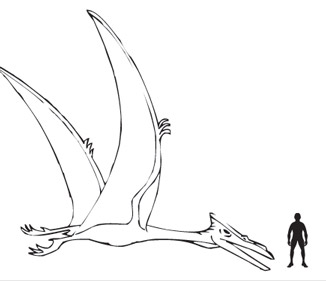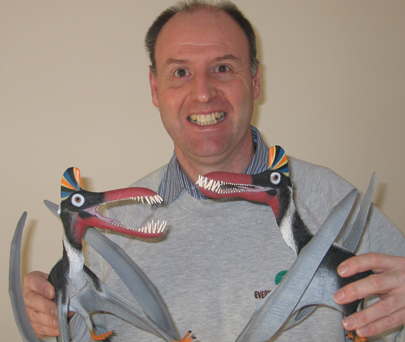Pterosaurs – New Research Provides Support for Orientation of the Pteroid Bone
Pterosaurs or as they are more commonly known, flying reptiles, were not dinosaurs, these remarkable reptiles evolved during the early part of the Mesozoic and they were the first vertebrates to master flight. Their evolution was all part of the Triassic diversification of the reptiles following the Permian mass extinction event that wiped out approximately 95% of all plant and animal species on the planet.
Pterosaurs
Although, many types of reptiles had evolved “wing-like” structures that enabled them to glide or parachute; it was the pterosaurs that evolved active flight, the ability to control with much more certainty the flying motion. From early, long-tailed rhamphorhynchoids such as the black bird sized Preondactylus, the pterosaurs dominated the air until the evolution of the first birds. The last of the pterosaurs such as the giant Quetzalcoatlus with its 12 metre wing span were the largest flying animals known in the fossil record.
An Illustration of the Huge Late Cretaceous Pterosaur Quetzalcoatlus

Picture credit: Everything Dinosaur
To view a scale model of a Quetzalcoatlus, dinosaurs and other pterosaur replicas, take a look at the Wild Safari Prehistoric World model range: Safari Ltd. Wild Safari Prehistoric World Dinosaur Models.
However, with no similar types of animals extant today, scientists have puzzled over a number of mysteries surrounding how these animals, particularly the largest genera, actually flew. The aerodynamics of the membrane of skin that stretched from the shoulder, to the wing-tip and down to an area near the hind limb were remarkable. The specialised arms of pterosaurs with their elongated fourth finger supported this double-sided membrane of skin that formed the wing, but how this wing was controlled to enable flight to take place has puzzled scientists for more than 100 years.
The position of a particular bone, the pteroid and how it could have withstood the stresses of flapping flight, as well as helped to direct the shape of the wing membrane has been a cause of much of the debate amongst scientists. Unfortunately, despite the relatively extensive fossil record of Jurassic and Cretaceous pterosaurs, the incomplete skeletons and their crushed state of preservation has led to confusion over the orientation of the pteroid bone and its role in powered flight. What was needed to help resolve this issue (or at least add to the debate), were a number of well preserved pterosaur skeletons with wrist bones and limbs that would enable scientists to obtain a 3-dimensional impression of a flying reptile’s wing. Despite the many superb specimens uncovered from the Santana Formation of Brazil, the fossils found to date were unable to provide conclusive evidence as to the orientation of pteroid bone.
The Pteroid Bone
The pteroid bone is a rod-like bone found exclusive in pterosaurs. It articulated at the wrist and supported the forewing in front of the inner part of the wing spar. The function of this bone and its orientation has been a source of contention amongst palaeontologists. Two contrasting theories have been proposed concerning the orientation of the pteroid bone. One group of scientists believe that it was orientated medially (towards the body), it pointed towards the body of the animal, leading to a forewing that was relatively narrow. A second theory suggests that the pteroid bone was directed forwards, away from the body during flight, resulting in a much broader forewing.
A Pair of Pterosaurs (CollectA Deluxe/Supreme Guidraco)
Picture credit: Everything Dinosaur
Images the skeleton of a pterodactyloid with a close up of the delicate pteroid bone that projects from the wrist and supports the forewing (propatagium).
In a paper published in the scientific journal “The Proceedings of the Royal Society Biology”, the team of researchers from Bristol University and University College, Dublin (Ireland), used biomechanical analysis and the testing of models in wind tunnels to test the position and orientation of the pteroid bone. The team discovered that the aerodynamic efficiency of the wing structure was greatly improved if the pteroid bone was positioned in an antero-ventral orientation (forwards and putting downwards). The lift : drag ratios were dramatically improved when the bone was put in this position when compared to other orientations for this bone. The team claim that the maximum lift generated is exceptionally high when compared to conventional aerofoils, permitting even the largest pterosaurs to take off and land without difficulty.
Commenting on the sheer size of some of the largest pterosaurs, Colin Palmer, from the University of Bristol and lead author on the paper stated.
“Based on existing fossil evidence, pterosaurs are believed to have had a wing span of up to 12 metres and a weight of between 80 and 250 kilogrammes.”
The absence of any similar sized flying animals today, makes assessments of the flying capabilities of large pterosaurs very difficult. The wing membranes of bats are also made of skin, but how they are supported by bones is very different to that which is seen in pterosaurs. The bat wing is supported by all the fingers except the first digit, the thumb and often extends beyond the back leg to reach the tail. Even the largest species of bats alive today do not have wingspans approaching anything near as large as some of the pterosaurs.
Commentating on the importance of understanding the structure and performance of pterosaur wings, a spokesperson said:
“It affects the speed at which they could fly, which could tell you about the type of life they led, where they lived, and possibly even what they ate. They are the biggest animals ever take to the skies.”
Such a light and delicate looking wing being able to provide powered flight to an animal with the dimensions of a small aircraft is a remarkable evolutionary achievement. The pterosaurs were around for something like 150 million years and they were the first back-boned animals to achieve powered flight. Further studies will no doubt be undertaken to explore their flight capabilities, perhaps focusing not just on the aerodynamic structures but analysing the brains and senses of these animals that enabled them to control and manipulate their huge wings.
To view scale models of a variety of pterosaurs, Everything Dinosaur recommends the: CollectA Deluxe/Supreme Model Range.







Leave A Comment